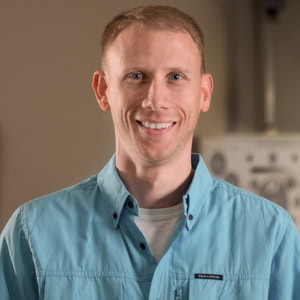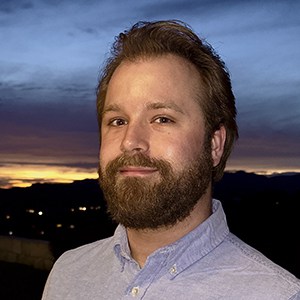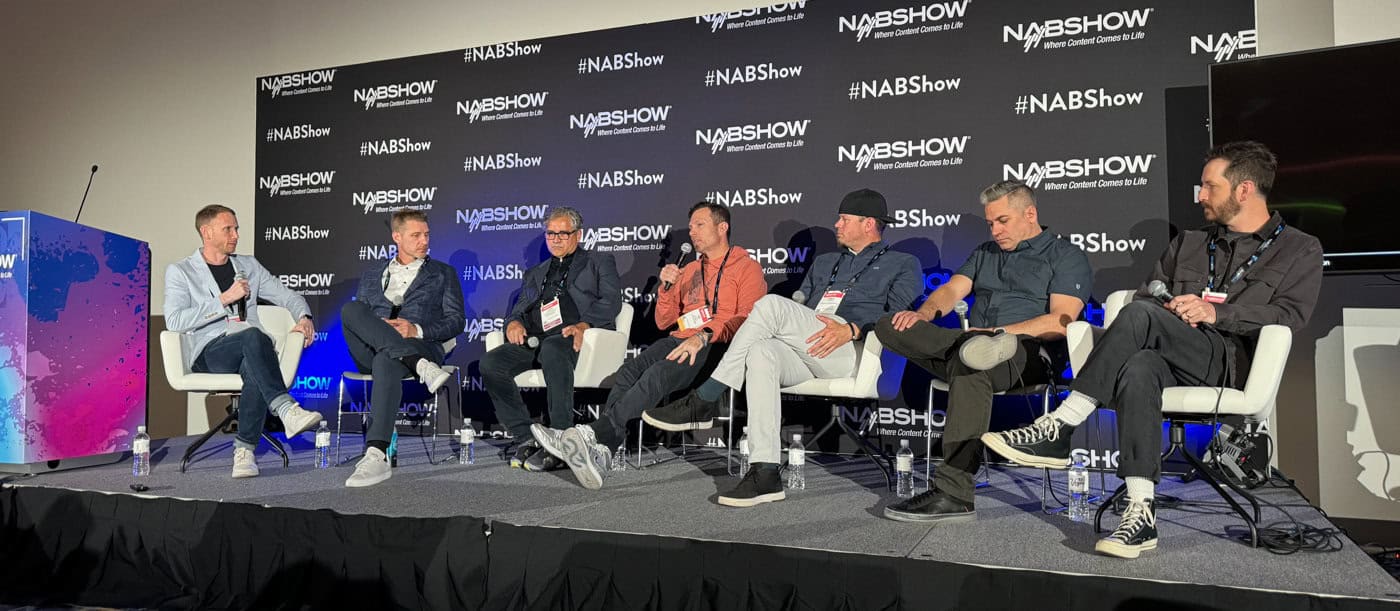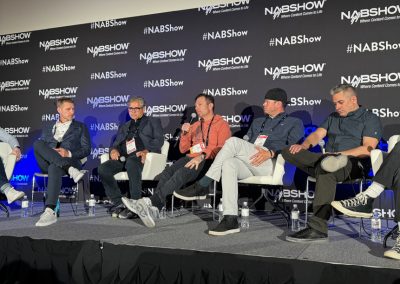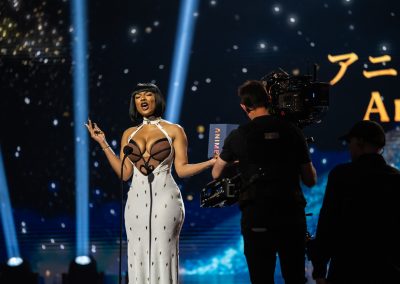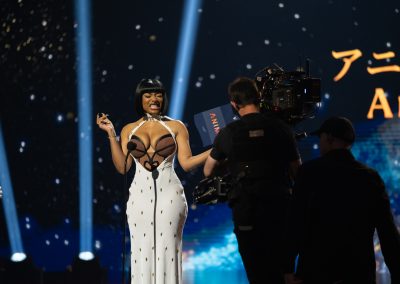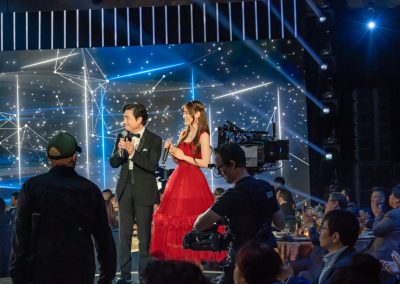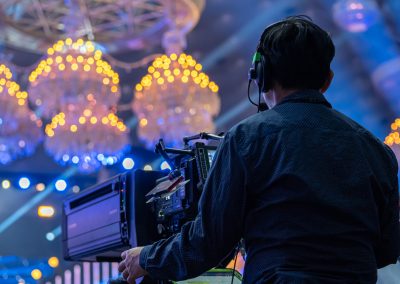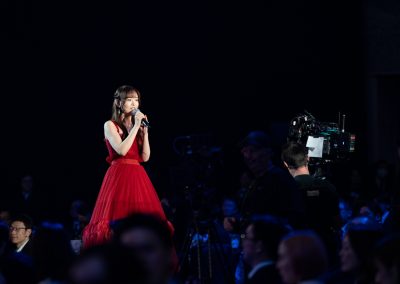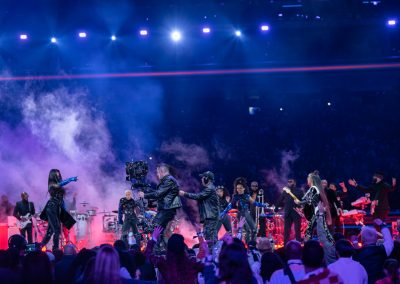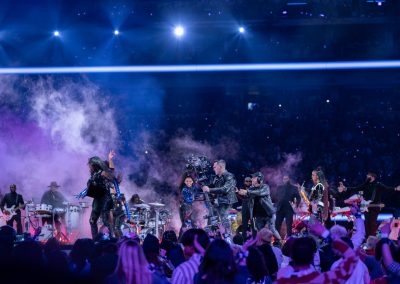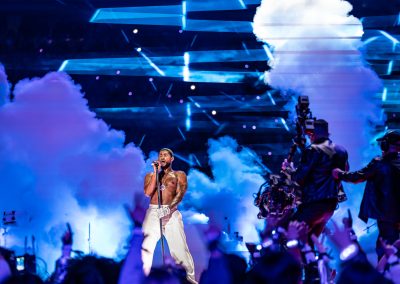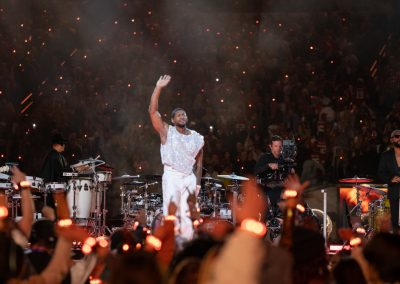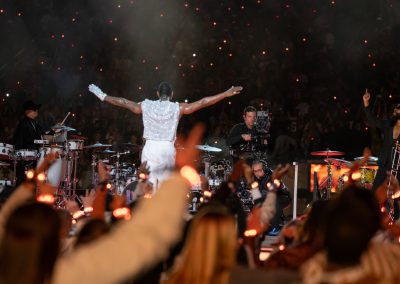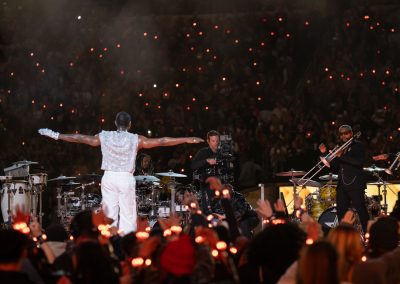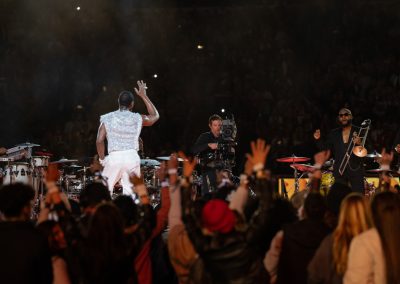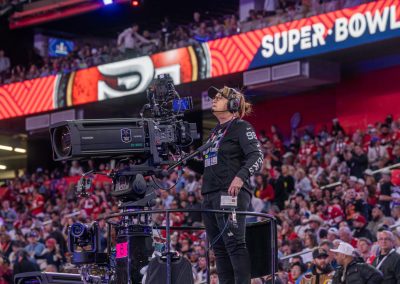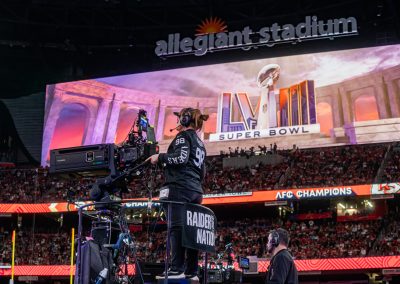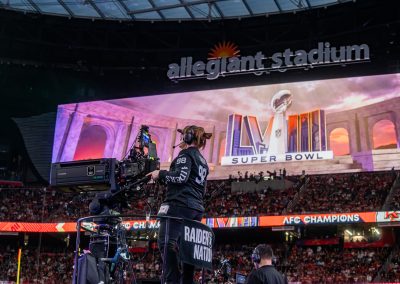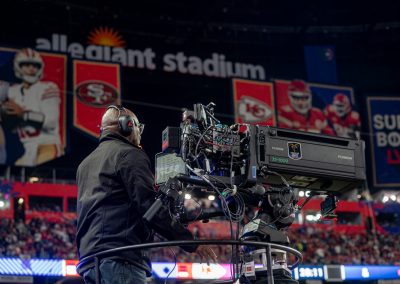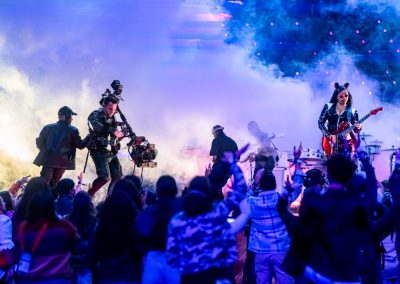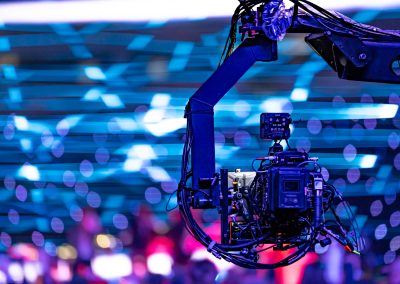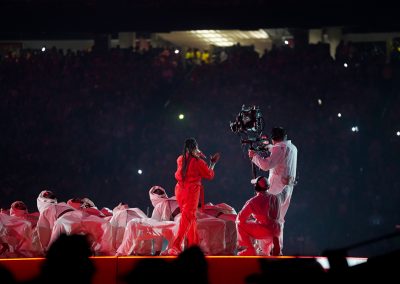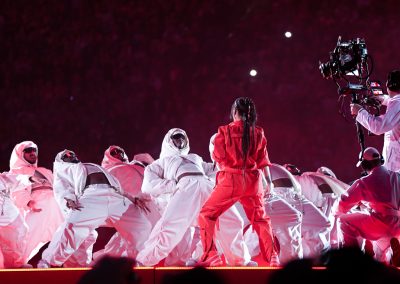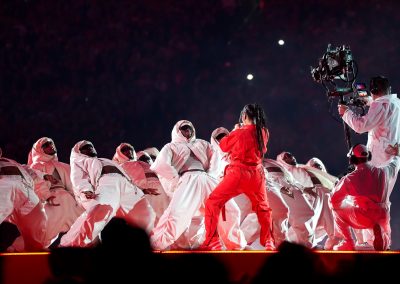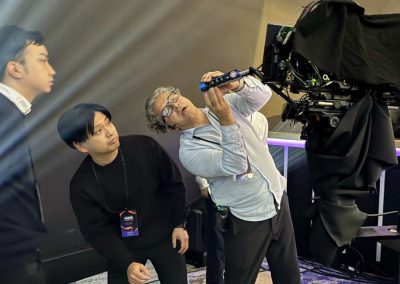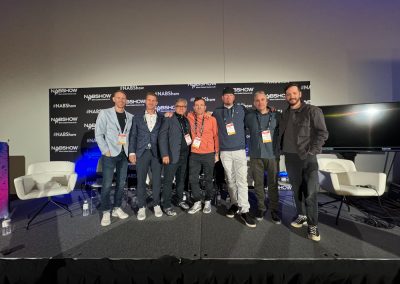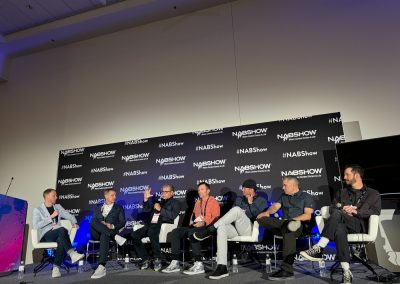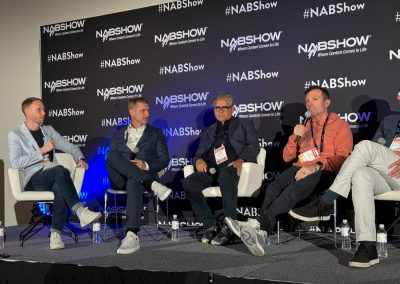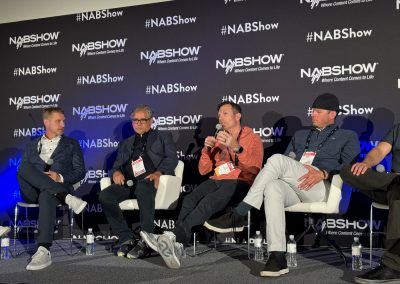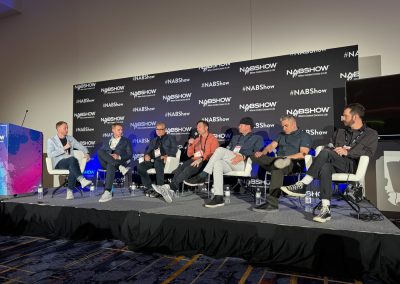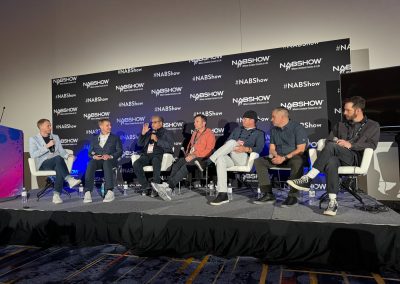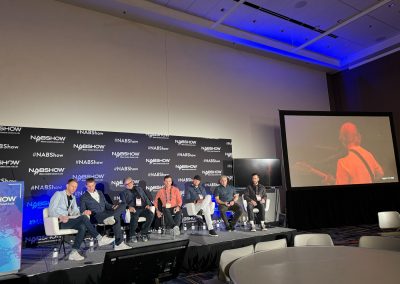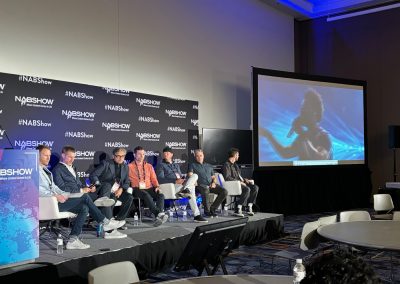Focus on Cine+Live
Insights from Pioneering Leaders Advancing
Creative Content Delivery
A Conversation with James Coker, Aaron Cooke, Morgan Kellum, Toré Livia, Jofre Rosero & Chase Smith
Moderated by Gabriel Mays & Recapped by David Daut
Where once a hard line stood dividing film from television and broadcast from cinema, the rapid advancement of filmmaking technology over the last few decades has caused that line to blur. These days, many of the biggest live events employ techniques and visual language that have traditionally been more associated with scripted, narrative filmmaking, pushing these broadcasts to become more cinematic in style and aesthetic. But even as these lines have blurred, the actual work that goes into shooting these events remains distinct from the world of narrative film and television as the images being captured often don’t come with the benefit of a second take.
On Monday, April 15, the NAB Show in Las Vegas, Nevada, hosted the Focus on Cine+Live conversation featuring a panel of professionals who have worked on some of the biggest live events of the last several years including the Super Bowl Halftime Show; Taylor Swift: The Eras Tour concert film; Billie Eilish’s performance at the 2024 GRAMMYs; the Crunchyroll Anime Awards; The Weeknd: Live at SoFi Stadium; Amazon Music Live; and Apple Music Live.
Making up the panel were James Coker, a a co-founder and head of technical development at Funicular Goats; Aaron Cooke, executive producer and CEO of Digital Cinema Collective as well as partner at Funicular Goats; Morgan Kellum, co-founder of Digital Cinema Collective and COO of Funicular Goats; camera operators Toré Livia and Jofre Rosero; and director of photography Chase Smith. The conversation was moderated by Gabriel Mays, Director of Rental at AbelCine.
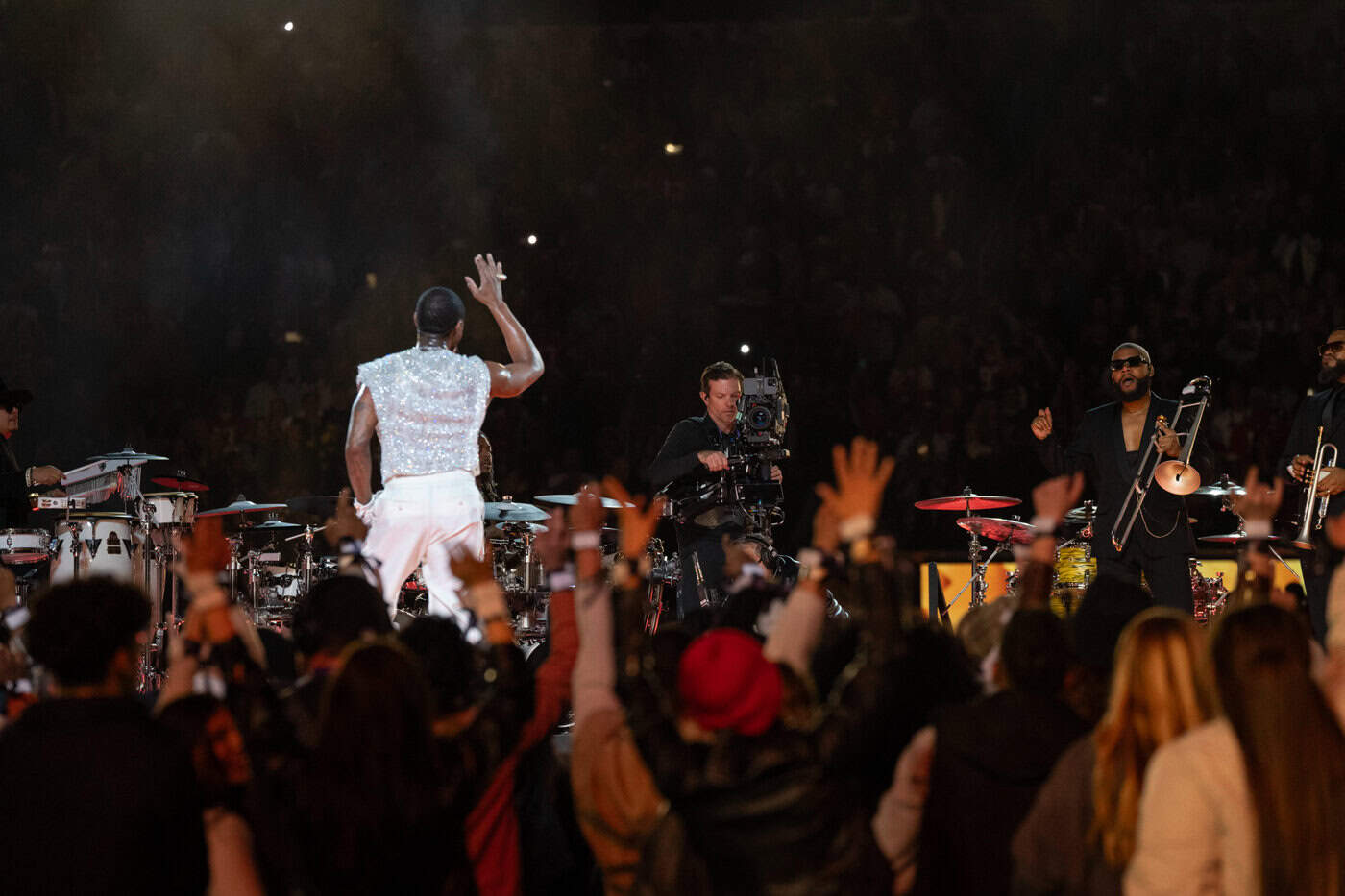
Camera operator Toré Livia shooting the Apple Music Super Bowl LVIII Halftime Show starring Usher
To open up the conversation, Mays started with the big question: What does “Cine+Live” mean in the first place?
“I do think that term is a little dicey at times,” Chase Smith answers. “It doesn’t always mean just throwing a cinema camera at it. Obviously, we’re using cinema cameras, but I think it envelops the whole idea of how we approach the shoot. We’re approaching it more how you would a narrative feature. How do we want this look? How do we want it to feel? How should we approach lighting this? What are the cameras? What are the lenses? What’s the access? What are the tools that we can leverage to create unique movement or no movement at times? What are we trying to express? That’s the differentiator of just shooting a TV show or a music performance versus we’re actually going to think through this beat-by-beat. Through all of that, I think you end up with more cinematic frames.”
James Coker elaborates: “Anyone can grab these cameras and try to pull off the show. The difference is how you utilize the camera and the team you assembled to make this show happen. How do you create and tell that story? There’s a lot that’s very important, from the operators, the camera AC team pulling the focus, showing off that depth of field, lighting it properly, exposing it properly. All of that comes together to creatively tell the story.”
Agreeing, Aaron Cooke adds, “I would just say that ‘Cine+Live’ is methodology. It’s a philosophy about really putting more artwork into each camera chain and taking the tools of cinematography, incorporating them into a multi-camera or a live environment. It’s really about more purposeful art and not just coverage of an event.”
As Mays notes, in the same way that giving someone access to great woodworking tools does not automatically make them a carpenter, simply using cinema cameras to shoot these events does not inherently make them ’cinematic.’ It takes vision and skill beyond mere access to the tools.
And yet, you cannot discount access as a factor for the spread of this style of filming. As Cooke observes, there’s a bit of a feedback loop where the technology gets more accessible, which leads to experiments and successes with the form, which leads in turn to increased demand. Toré Livia notes from his perspective that when given the choice, he’ll opt for shooting with cinema cameras every time for their improved performance in low-light settings.
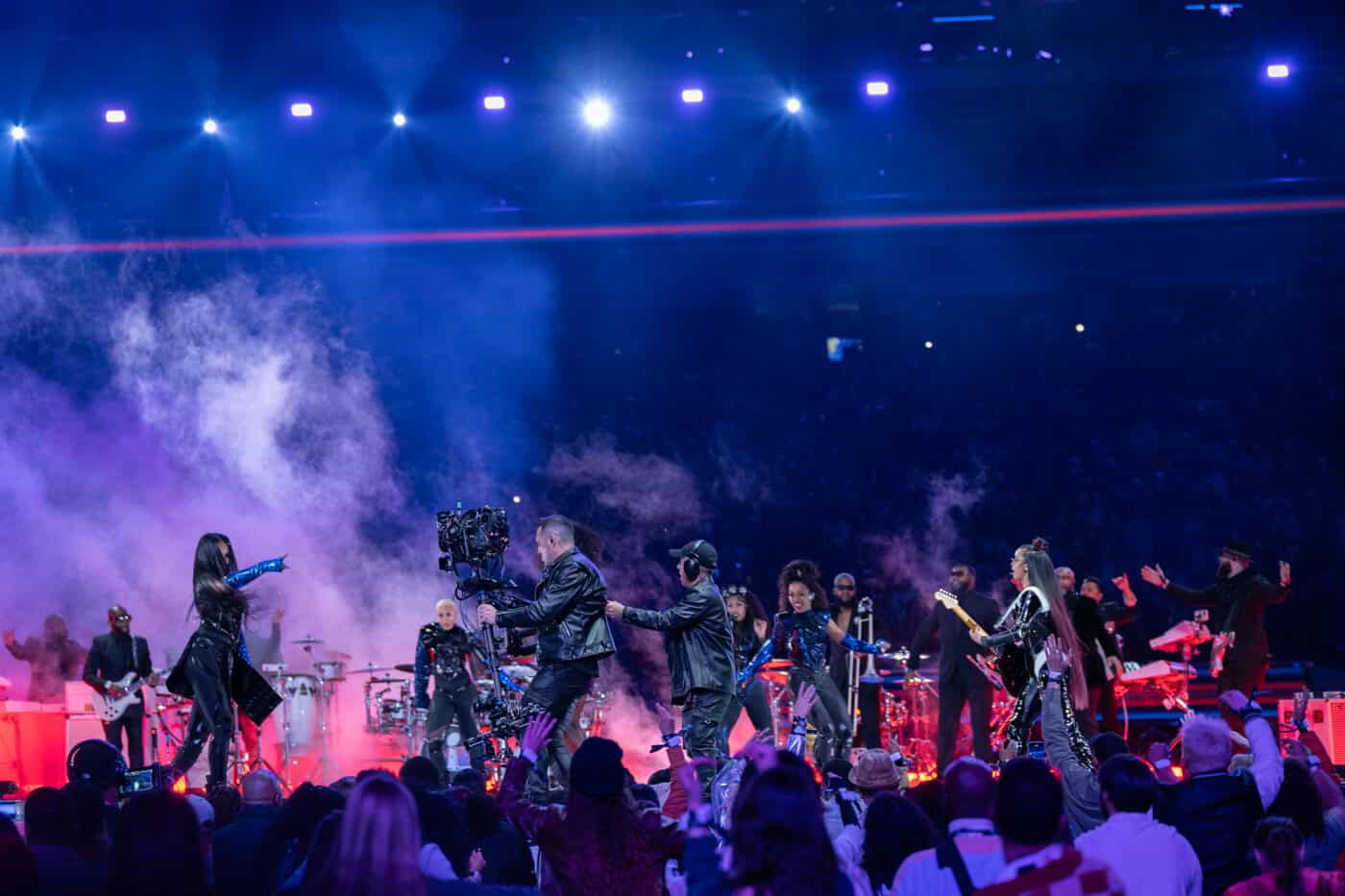
Camera operator Sean Flannery, assisted by Steadi Utility Drory Yellin, shooting H.E.R at the Apple Music Super Bowl LVIII Halftime Show
“I think it’s kind of a sea change,” Morgan Kellum adds. “It’s happening faster than anything we expected. I think it’s showing that these big events are possible with a cinema workflow and that it’s reliable, consistent, and you have all these extra tools that lead everything. So, you bring in a forward-thinking director, bring in a forward-thinking producer, and once they see the dynamic nature of these cameras and lenses and of the operators themselves, those kind of things are what stick with people.”
Perhaps the most visible stage for this sea change is looking at the Super Bowl Halftime Show. In recent years, the filming of these performances has become noticeably more vibrant and dynamic, but that change doesn’t come without its own set of challenges, as Jofre Rosero recalls from shooting The Weeknd’s performance during Super Bowl LV in 2021.
“When I had to transition from shooting The Weeknd, to then shooting the hip hop show down on the field, I had to change lenses in the middle of the performance. Now I’m having to struggle. If you don’t make it to a shot that is pre-planned, millions of people are going to see it. So, you have to compensate for both. I have to compromise and see where I’m going with this. Am I going to be able to make it? Am I going to fail? For The Weeknd, the shot that was done inside the light room, that was one of my shots, and that was with a wide-angle lens. Now I have about three minutes to change to another lens, but the pressure goes to your head and you just start thinking, ‘What if? What if? What if?’ Fortunately, I was able to do it and it was beautiful, but like everything, you have to get used to where you can compromise and where you cannot, and what is this story asking for.”
As the filming of these live events has pushed into a more cinematic style, so too has the role of director of photography become more prominent and important on these shoots. As Smith notes, “Having a DP on these shows is a new thing. Previously, it was a camera supervisor who would be in charge of making sure the crew is in place where they need to be, that the camera setups are how they should be, and moving things accordingly. But having a DP has definitely brought into the fold conversations of lighting and more knowledge of different lenses from the cinema world.
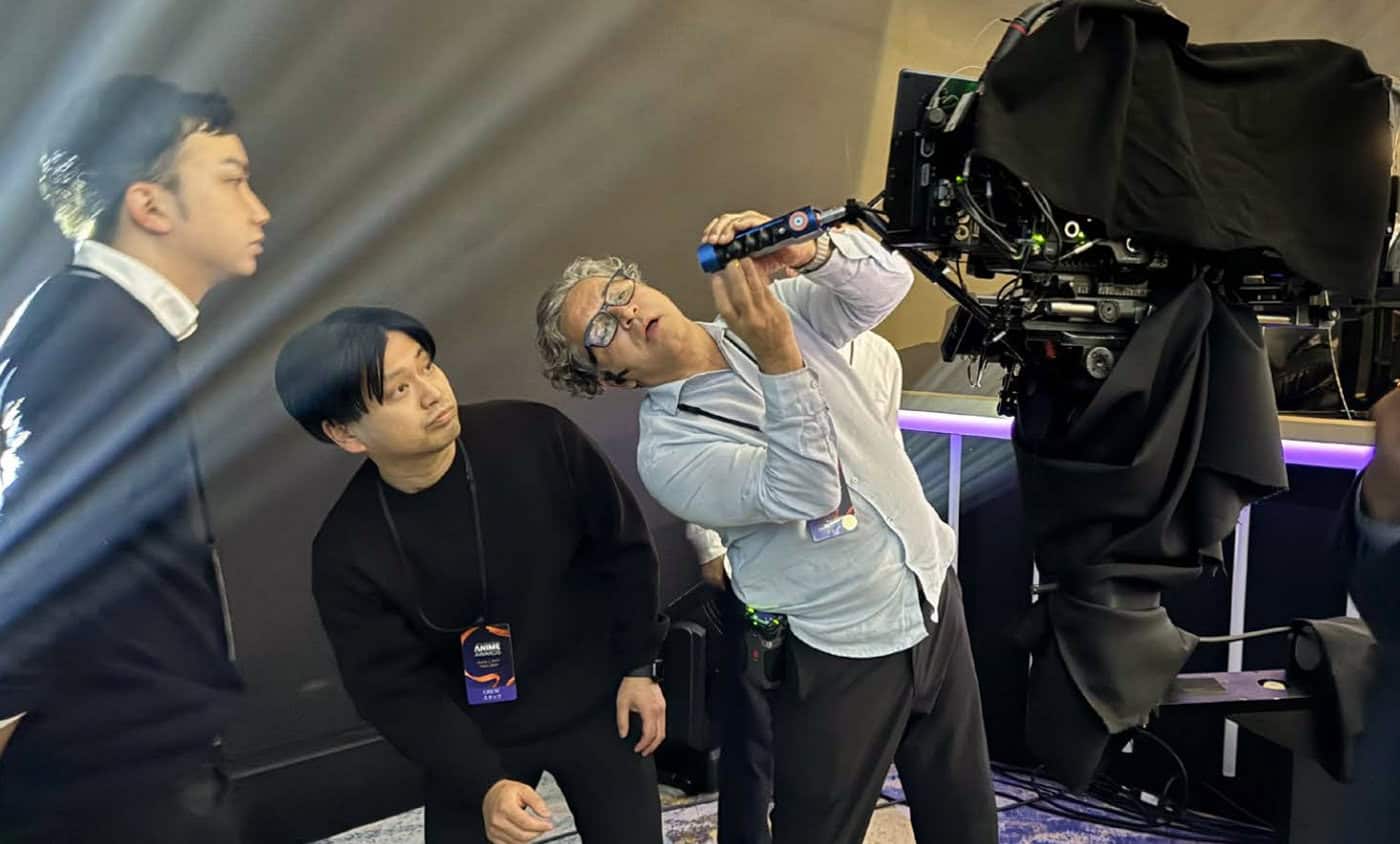
Camera operator Jofre Rosero preparing for the 2024 Crunchyroll Anime Awards. Photo by Morgan Kellum
I don’t have any broadcast knowledge, I didn’t come from that world. At a certain point I’m working with camera operators and the shots quite a bit personally, and then when the show begins, the way I see it is they’re the director’s cameras now. I am there nudging and saying stuff to help, but they are no longer my cameras. They are the director’s cameras.”
One of the biggest differences, however, with working as a DP on a live event versus a narrative project is that you have less control over the lighting setup. Smith continues:
“The conversations with the lighting designers—especially from the touring perspective—are tough. It’s better if you know that LD and have worked with them previously, but ultimately it’s about getting them to sign up to do more work. Because the show’s already set at that point; they’re basically just pressing play and letting the show go just like the other ones. But now we’re making them change stuff, tweak colors, add this, take that away, and we’re typically bringing in a fair amount more lighting on top of their package. For The Weeknd’s HBO special, that was driven from a previous shoot we had done with him, that we had lit on a closed stage. His tour, in a way, was modeled after that, and a lot of that was not wanting key light. That seems awesome, but there are times where it’s not so awesome, where he’s really hard to pick up or find. Essentially he’s out in the world; he’s lit by color, backlight, that sort of thing. Definitely a stark difference between that and a traditional pop show, because he just wants to be enveloped in the world.”
Beyond the differences in lighting, though, the most obvious and essential difference with shooting live is the simple fact that it is live. As Mays notes, there’s no going back to one. Because everything has to be dialed in ahead of time, Coker stresses the importance of having a vision that is both clear and clearly communicated.
“When you get one pass at a live concert shoot, you get one night. Sometimes we do get multiple nights, but when you only get one shot, I think it’s important for the director, the DP, everyone to create that vision of what they want to capture during that pass. Maybe it means going to one of their earlier shows, then having a meeting with all the operators, with the director and DP sharing exactly what each operator needs to capture. They have to create that vision in order to capture it, because if you don’t communicate that story, how is the operator going to know how to capture it? It’s important to have that meeting prior to a show, explain what they want, and for the operator to understand what they need to do during the show.”
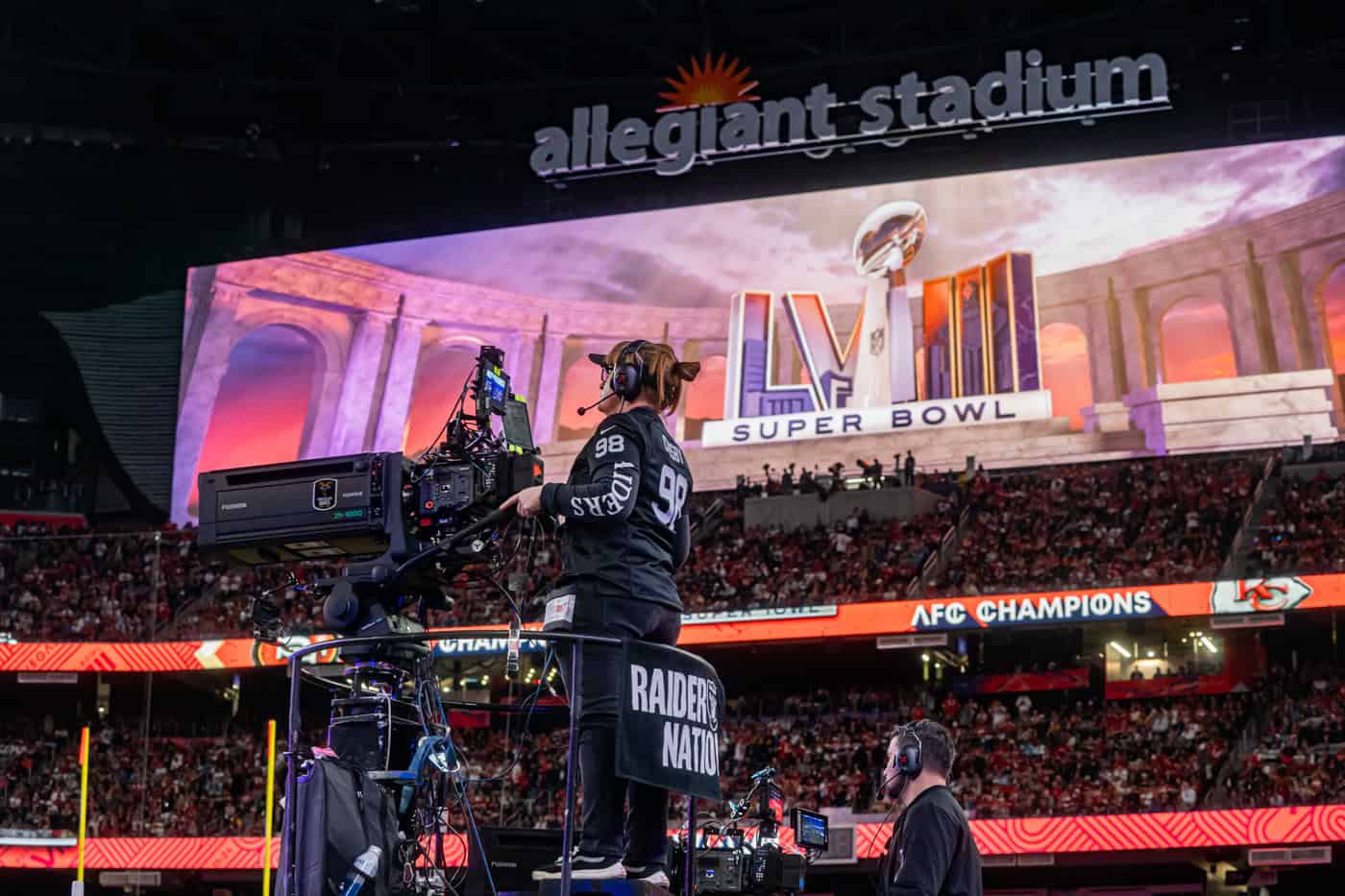
Camera operators Kary D‘Alessandro (left) & Keyan Safyari working the Apple Music Super Bowl LVIII Halftime Show
But even if that vision is clear, you still need a skilled, creative team in order to execute it. When things are happening live, it’s down to the crew to make smart calls in the moment, and that means assembling a team that is up to the challenge and able to think on their feet. Smith elaborates:
“When you have a lot of cameras, there’s only so much you can look through each viewfinder and see every possibility of the shot. So, part of finding the correct operators is knowing their personalities. It’s impossible to know what you’re going to get from someone you’ve never worked with, so knowing the people who are doing this, and knowing how to assign them to a camera, is a huge part of it. There are positions that need years and years of experience, there’s no doubt about it, and those folks come from the broadcast world. That’s invaluable still, even in this cinema format. And then there are some positions where you want someone who’s never been in this position, so they’ll get a little more experimental and they’re automatically seeing things a little differently. But I would say to the camera operators, they are the doers of the plan. We cannot do anything without our ops. They are the ones who are seeing, that is your position. You are seeing all the issues very quickly with your shots, so identifying and caring enough to make mention of, ‘Hey, if that mic stand moves three inches to the left, I can see the fretboard, and right now it’s obstructed.’ Those kinds of moves are invaluable.”
Beyond skill, though, the crucial element of assembling a solid team is finding people who not only work well, but who work well together.
“I believe in energy big time,” Rosero says, “and creativity gets hurt when bad energy, bad juju are around you. If you have somebody who’s problematic, then you want to stay away from that person as much as possible. If you have an AC that’s saying, ‘Oh, no, no, we cannot do that.’ Okay. Why not? So you start having a negotiation and that takes away from the content you want to film.”
Cooke agrees, adding, “When you think about the teams that we’re working with, it’s like having an elite team of athletes. They’re all the best, and they’re very competitive amongst themselves; always hunting for the shot and competing for who wants to get this next shot. When you have a director saying, ‘Alright, camera ops, give me a beautiful shot,’ I know they’re out there and they’re competing, but this is our competition. We’re playing at that level, but it’s also fun. We’re having a lot of fun.
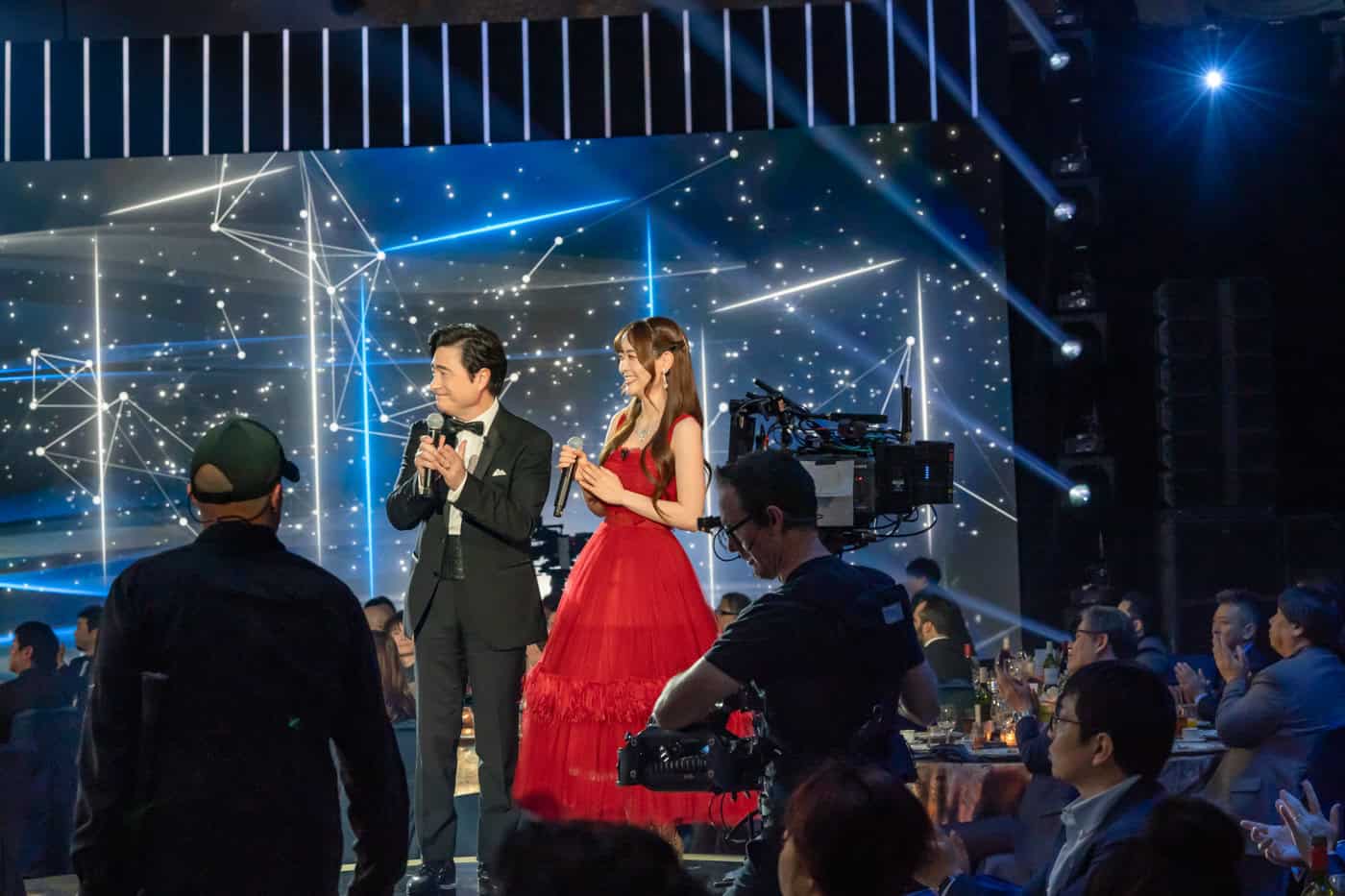
Filming hosts Sally Amaki & Jon Kabira at the 2024 Crunchyroll Anime Awards
“I think for anybody to succeed in any position in this industry, it’s about getting in on the ground floor, being humble, really wanting to learn, and getting every opportunity that you can to go in and work with new people. Be somebody that you would want to be around, and somebody that’s going to be a part of the family, because that’s what is. It’s not just show to show. We all end up working with each other throughout the year on different projects. We come and we go, but you know the people that make it a stressful environment, where you don’t wake up happy to go to work that day. And then, you know the people that are a joy to be around and you’re happy to go to work with. So, as you develop your network of people, it’s really about developing the network of people that you want to be around and that are going to help lift you up. And you’re going to add value to their team as well, because you’re positive to be around.”
Finally, the panelists stress the importance of carefully choosing the jobs you want to take. Rosero recounts some harrowing tales about working the news beat in the early 1990s and what that taught him about where his passions lie.
“I cannot do news. I cannot do anything where I see people being hurt. I stick to music and fun, and I think I’m doing pretty well. Whatever way you want to go, just make sure that is what you really like, because there’s nothing worse than going into work when it’s not something you want to do. Yeah, you know how to pull focus, you know how to frame it, but if what you’re shooting is not what you are intended to do because it’s not your passion, then go for whatever is your passion. That’s when you’re going to be your best self.”
Cooke reaffirms this, saying, “We all have to pursue a paycheck, right? We all have to take those jobs where we get the paycheck. That happens especially early on in the career where you’re balancing job to job. But as you’re able to accept the shows that you want to be on and the ones that you love, pursue the ones that you’re passionate about. That passion will show up in your work, and you’ll be a lot more successful that way.”
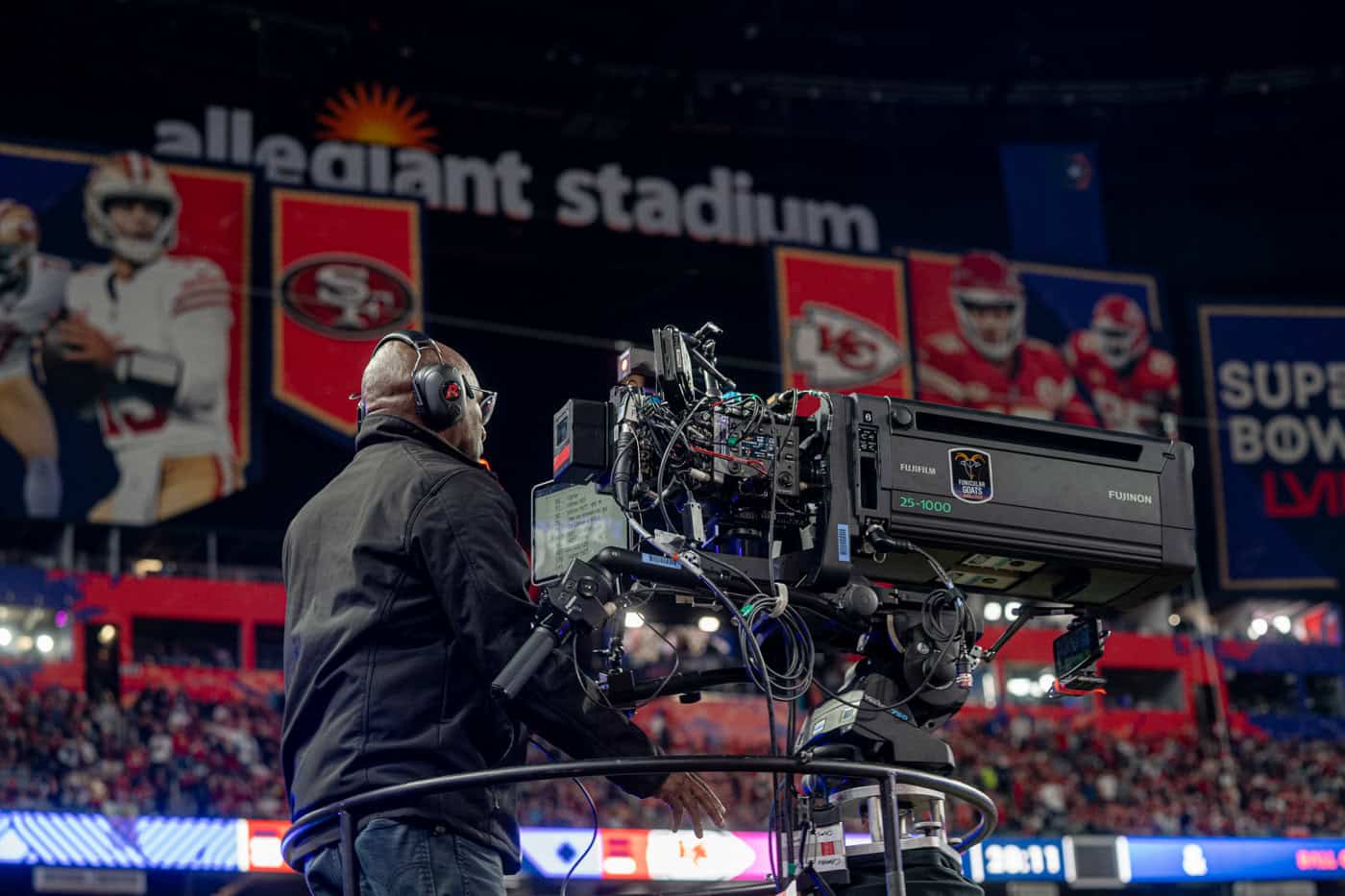
Camera operator Allen Merriweather working the Apple Music Super Bowl LVIII Halftime Show
Camera Operator Summer 2024
Above Photo: The Focus on Cine+Live panel, from left: Gabriel Mays (moderator), Aaron Cooke, Jofre Rosero, Toré Livia, James Coker, Morgan Kellum & Chase Smith
Panel photos by Claire Orpeza Lee; BTS photos by Brianna Resuta
PHOTO GALLERY
Select Photo for Slideshow
SIGN UP FOR THE FREE
DIGITAL EDITION OF
CAMERA OPERATOR
Click Here
James Coker
Co-founder & Head of Technical Development at Funicular Goats
James Coker is one of the entertainment industry’s most sought-after technical managers, recognized for his innovation and leadership in the booming world of cinematic multi-camera production. Coker serves as Head of Technical Development for Funicular Goats, which develops state-of-the-art cinematic systems and technical capabilities for an extensive roster of industry leaders including Apple, Netflix, Disney, Google, Amazon, and HBO. Coker’s most recent projects include the Super Bowl LVIII Halftime Show (his fourth consecutive year as Tech Manager), Taylor Swift: The Eras Tour, Crunchyroll’s Anime Awards, various Apple Music Live specials, and Amazon Music Live’s Thursday Night Football Concert Series. In addition, he has managed projects for iconic musicians and comedians including Billie Eilish, Harry Styles, The Weeknd, Elton John, Adam Sandler, and many more. Coker cultivated his expertise over more than two decades of hands-on experience across hundreds of feature film, television, live broadcast, and commercial projects around the world. Launching his career with 12 years at Panavision, he had a hand in the first wave of cinematic multi-camera production, helping the company introduce the technology for sitcoms. He then spent time managing multi-camera cinematic projects for VER/PRG Gear before co-founding Funicular Goats to continue innovating in the burgeoning space. He continues to lead the company’s development of new technologies and workflows to produce unparalleled visual quality for some of the world’s biggest companies, shows, and events.
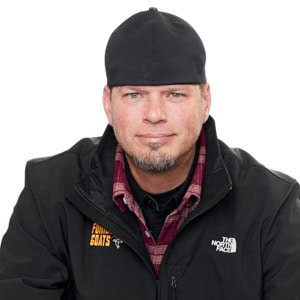
Aaron Cooke
Executive Producer & CEO of Digital Cinema Collective; Partner at Funicular Goats
Aaron Cooke is an Emmy®-winning producer bringing cutting-edge broadcast technology to some of entertainment’s largest television shows and live events. As Co-Founder and CEO of Digital Cinema Collective (DCC), he has developed a roster of clients including Disney, Netflix, Google, Apple, Sony, FOX and the NFL. In ongoing conjunction, Cooke has produced multiple Emmy-nominated Super Bowl Halftime Shows, leveraging state-of-the-art systems to capture the event with cinema cameras for the first time. Beyond bringing the Super Bowl Halftime Show to 130 million viewers and helping it garner its first-ever Outstanding Live Variety Special Emmy, Cooke has produced many of the entertainment industry’s biggest shows, including Disney’s variety holiday specials, Amazon Music’s Amazon Music Live series, and the 8th Annual Crunchyroll Anime Awards. He has also overseen such productions as the Leaders Summit on Climate, the largest-ever virtual gathering of world leaders and the first ever hybrid live/virtual event held at the White House, along with several National Geographic Live specials. Cooke’s latest project includes the live shows for Netflix’s new live-streaming service. Throughout his career, Cooke consistently pioneers emerging broadcast technologies, such as integrating live stream feeds into televised broadcasts while harmonizing a cinematic workflow into live or live-to-tape projects. Cooke’s primary goal surrounds enhancing visual aesthetic and servicing storytelling capabilities.
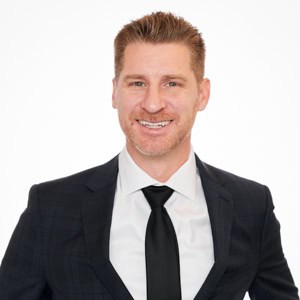
Morgan Kellum
Co-founder of Digital Cinema Collective & COO of Funicular Goats
Morgan Kellum, also Founder & COO, Digitial Cinema Collective, has been at the forefront of the burgeoning world of cinematic multi-camera production, helping develop the technology and systems to bring unparalleled visual quality to some of the biggest live events in the world. Kellum has overseen the technical integration of the last four Super Bowl Halftime Shows, implementing new technology to broadcast the shows live in cinema quality for the first time (earning the show four Emmy® wins). Kellum’s most recent projects include the 8th Annual Crunchyroll Anime Awards, the Super Bowl LVIII Halftime Show, Rivian’s R2/R3/R3X Launch Event, Taylor Swift: The Eras Tour, and Amazon Music Live’s Thursday Night Football Concert Series. Among the other major global events for which Kellum has overseen technical production are David Gilmour: Live in Pompeii; Victoria’s Secret in St. Barths; the Leaders Summit on Climate, as well as arena shows for The Weeknd, Lady Gaga, and Elton John. He has produced content for nearly every major platform, including Netflix, HBO, and Amazon. Kellum was instrumental in major streamers’ shift to cinematic capture for comedy specials, overseeing projects for comics including Sarah Silverman, Jerry Seinfeld, Kevin Hart, Steve Martin, and Dave Chappelle.
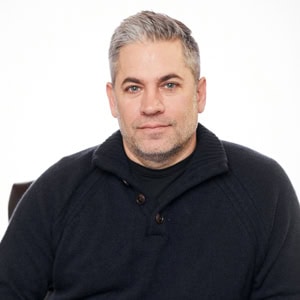
Toré Livia
Camera Operator; Co-owner of Jitacam
Toré Livia is a 12-time Emmy winner and winner of the prestigious English Guild of Television Camera Professionals Award for his 4-minute opening steadicam shot in Grease Live. He is also a DGA multicam director, with such shows as The Crunchyroll Anime Awards, Miss USA and Beyoncé in Dubai. Toré also is a co-owner of Jitacam, which owns and rents out specialty equipment for TV and Film productions. Learn more at IMDb.com
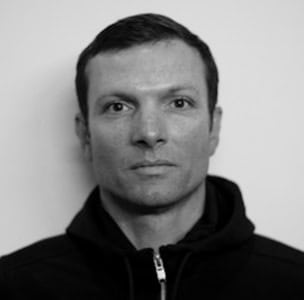
Jofre Rosero
Camera Operator
Jofre Rosero is known for The 25th Anniversary Rock and Roll Hall of Fame Concert (2009); Adele: One Night Only (2021); and Cher: The Farewell Tour (2003). Learn more at IMDB.com
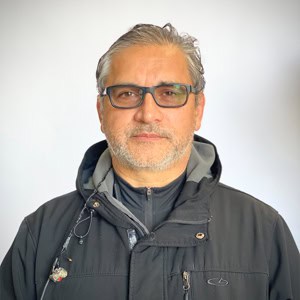
Chase Smith
Director of Photography
Chase is a multi-cam director of photography specializing in music performance and known for his work with popular music and television platforms. He utilizes cinema cameras to elevate capturing live performances. Despite not growing up in a broadcast background, Chase continually pushes the boundaries of multi-cam storytelling through the use of cinema cameras, lenses, and lighting techniques. He thrives on working closely with directors, approaching projects with a blend of visual language, technical precision, and genuine communication. Chase has collaborated with artists including The Weeknd, Post Malone, The Raconteurs, Alicia Keys, Lady Gaga, Camila Cabello, Billie Eilish, Lizzo, Khalid, and SZA. Learn more at IMDb.com
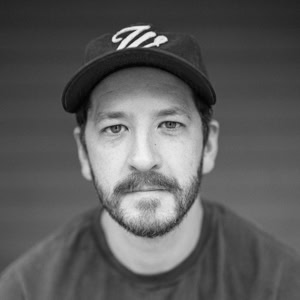
Gabriel Mays
Director of Rental, AbelCine
As Director of Rental, Gabriel Mays oversees growth of Rental by nurturing business relationships and unifying the customer experience nationwide. In his previous role as the LA Rental Manager, Gabriel worked with producers, cinematographers, and assistant camera operators to provide the highest level of customer service possible. He also ensured that all their equipment needs are met on budget. Before coming to AbelCine in 2015, Gabriel previously worked as a communications instructor and electronic media engineer at a private university. He taught various courses in electronic media, including film, broadcasting, and digital arts. Gabriel is an award-winning cinematographer, director, producer, and editor known for his innovative research and implementation of new film techniques. He was also one of the first to implement HDSLR cameras into filmmaking. He has been the cinematographer on dozens of independent films, documentaries, and music videos.
